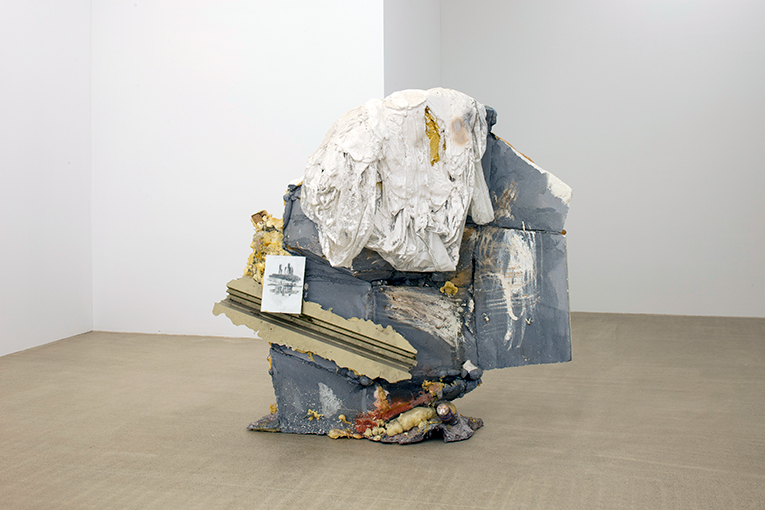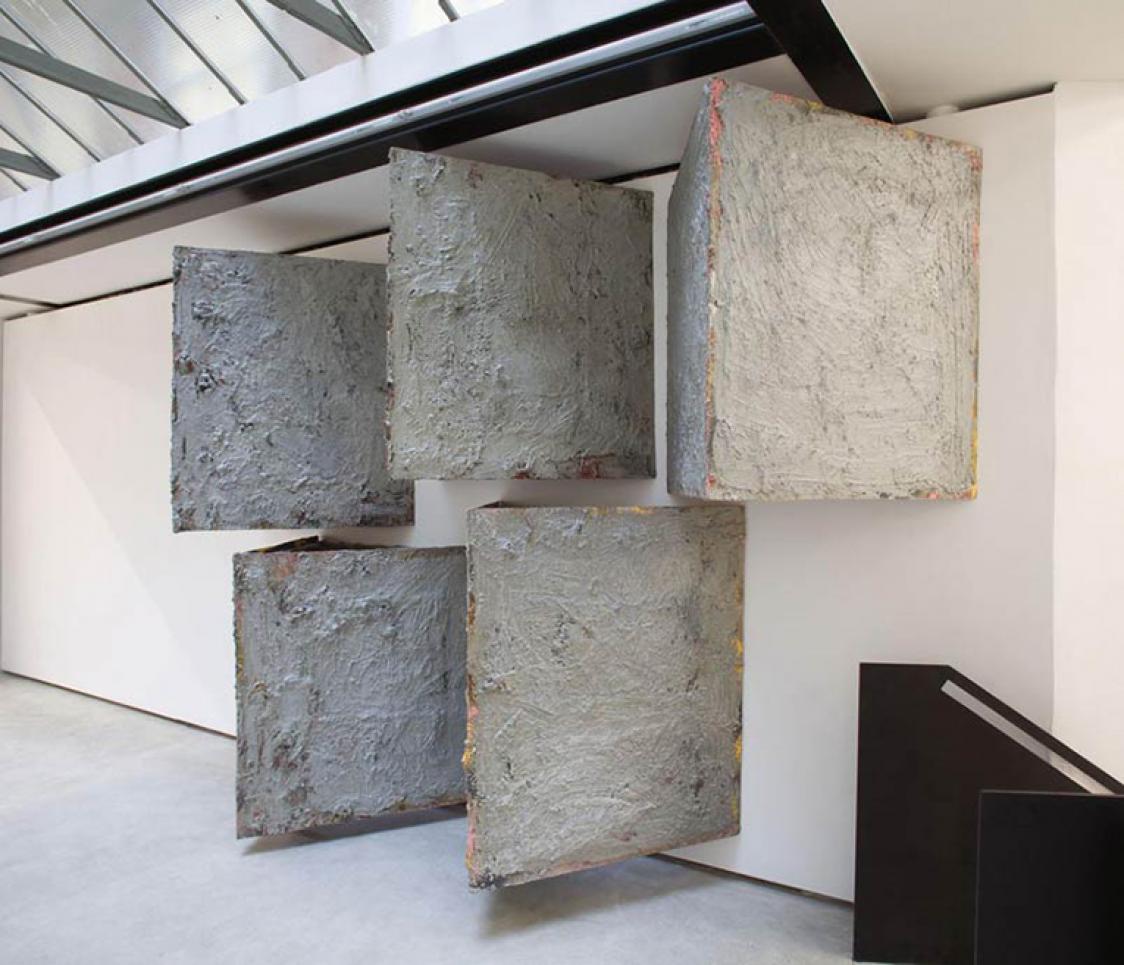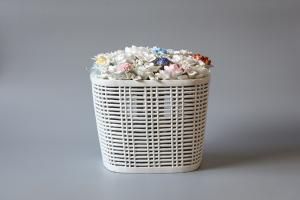DISPLACED FRACTURES – ON THE FRACTURES
( An initiative of the Siemens Stiftung and the migros museum für gegenwartskunst)
migros museum für gegenwartskunst / Hubertus Exhibitions
December 11, 2010 – February 20, 2011
Since time immemorial, art has possessed sensitive antennae for all that is fragile, porous and vulnerable in humans. In this group exhibition, the fractures in human nature are not, however, negotiated directly with the body itself, but rather through representative forms of architecture. The fractures and interfaces of buildings form metaphors for the fissures in human existence.
The eponymous term “Displaced Fractures” derives from medicine and describes the phenomenon whereby bone fractures appear at a place other than where the main strain is. The term “displacement” is also found in psychology. In the new rooms of the migros museum für gegenwartskunst, mainly installations, room interventions and sculptures are on display, which work with this shifting of symptoms. There is a tension that dominates between form-denying and monumental shapes, between subjective and rational-formal gestures.
In this analogy contained in the term “Displaced Fractures”, building materials both inherently stable yet also subject to temporality present projection surfaces,on which sensitivities and questions of existence can be played out. By the act of transference onto what is seemingly solid, this sculptural discourse reveals what is precarious today, making it tangible.
The formless, already used by Rosalind Krauss and Yves Alain Bois as a symptom of the suppressed, is developed in the exhibition by such artists as Klaus Winichner or Phyllida Barlow into material and form. Yet in so doing, it is not alienation that is thematised, as is the case with Oscar Tuazon and Kilian Rüthemann. Instead the artists address the impossibility of expressing fractures and stubborn viability by means of variants on buildings.

Inanimate material turns into a metaphor for the body, as shown in Klara Liden’s work, whether in cautious construction or spontaneous disintegration. The works show the structures of architecture just like the traces of the personal. These are precise postures, in which the intensification of form is made specific, as shown in Emilie Ding’s concrete support constructions, or Ulrich Rückriem’s stone blocks.
Particularly the dynamic deployment of colour and the use of free forms shape the subjective interventions. They are evidence of the human, wielding in a way that is free and defiant, so as to hint ultimately at the fragility both of the present and of memory. For this joint project the Siemens Stiftung was fortunate in securing an outstanding partner – the migros museum für gegenwartskunst. Curated by Heike Munder (migros museum für gegenwartskunst) and Thomas D. Trummer (Siemens Stiftung), the exhibition is presented in the new premises of “Hubertus Exhibitions” in the Albisrieden district of Zurich.
The Exhibition
Artistic dialogue with the present reveals itself to be wayward. Existential questions, more urgent these days than ever, are shown in monumental sculptures and subjective positioning. In the exhibition “Displaced Fractures – On the Fractures of Architecture and its Body”, material-intensive installations in hard and durable materials are on show. Concrete, stone and synthetics are nonetheless presented in the process of disintegration. Sculptures and installations thus symbolise the questions of a modern-day “condition humaine”.
Exhibition Artists
Phyllida Barlow (*1944, Great Britain) has been working intensively with the genres of sculpture and installations since the 1970s, and since this time has worked in the tradition of the post-minimalists against the legacy of an aurainvested object; she has also taught at various art academies. In her works raw materials pile up thus creating dense form clusters. Bundled up in part into dwellings, they always show an elementary physical presence, which long opposed not only the smooth aestheticism of minimalism, but equally the polished aesthetics of the likes of Jeff Coon or Haim Steinbach, that were popular in the 1980s, and which only now enjoys wide recognition.
Tacita Dean (*1965, Great Britain), former student of Phyllida Barlow at the Slade School of Fine Arts in London, works mainly with the media of film and sound. In particular she is interested in the transition from the elapse ot time to a narration that is fueled by expectations. Among her most well-known works is the film Palast (2004), which was shown at the 2005 Venice Biennale. It concerns a portrait of the Berlin Palace of the Republic prior to its destruction. The demolition of East Germany’s showpiece building triggered fierce citizens’ protests – the steel and glass edifice was meant to be replaced by a reconstruction of the much older Berlin Palace, which once stood on the same spot. The evaluation of cultural history as a political signal is something that Dean employs not in the form of a noisy protest, but rather a quiet elegy. Golden light effects, shadows, and strange colourings show insights using slow, reflective camera work.
The sculptural works of Emilie Ding (*1981, Switzerland) provoke discourse on American minimalism. Ding places striking elements of form, in which serviceability is always hinted at, on the exhibition floor. These are pieces of concrete, angular and provided with steel bolts, looking like hinges, support elements or theatrical props from architecture. The way these blocks are arranged and cut form a dialogue with formal discourses. The allusion to minimalism is also reflected in the concept of seriality, though Ding’s sculptures are unique originals which reveal barely visible imperfections.
The functionality and failure of urban spaces is one of the central themes in the works of Klara Lidén (*1979, Sweden). She creates installations using existing materials such as cardboard or torn-off poster papers. The assortments resemble historical decollages, and speak the language of rebellion against material and the environment. Likewise she occupies public space in her video works by physical actions that seem strangely dislocated, when she dances down to the underground, or performs the “moonwalk” in the streets of New York. Provocation and uproar against all the regulations of public life are always a feature in this. In her video work Position 0310, 2010, the artist clings like a solidified animal to public facilities such as gas pipes and advertisement pillars, and remains almost invisible in the pulsating traffic.
Ulrich Rückriem (*1938, Germany) is among the most important of Germany’s post-war sculptors. Precision in his craftsmanship and a marked threedimensional awareness determine his work, which is shaped by monumentality and formalism. He absorbs ideas and procedures from American Minimal and Concept Art, while still creating independent work. Closed stone blocks are sawn into pieces or drilled into, to enable memory and historicity to be legible from hair cracks, cutting edges and fractures. The work process and the precedingconcept for it are the focal point for Rückriem.
In his works Kilian Rüthemann (*1979, Switzerland) subtly tackles the architectural qualities of exhibition locations. The aesthetic of his work is determined by the uncovering of structures and the search for the labile and fragile in what appears to be solidly standing. In the attempt to elicit from the rooms hitherto unnoticed poetry, he also resorts to more brutal means, when he for example pours out an extra concrete floor onto steps, which makes access considerably less comfortable.
Oscar Tuazon (*1978, USA) is interested on the one hand in the tension between architecture and nature that is shown in the collapse of public space, on the other hand, however, in the extreme state of nature that is hard to tame. He transfers the essence of this debate into the exhibition room using reduced architectural language, and simple building materials. At the same time he shows great interest in a formal language of form by combining hard and soft elements. Tuazon allows a second inner structure to grow within the architectural realities of the exhibition rooms, with two architectural levels opposing each other, that of the inner which lodges itself, and that of the external, which encases it.
At the heart of the work of Klaus Winichner (*1967, Germany) is the involvement with the human portrait, which in turn points to sculptural discourses. In various media such as sculptures, paintings and drawings he approaches the theme, often using industrial building materials or rubble. The portraits are created not only by depiction, but also by fragmentary architectures that represent the human. They are abstract assemblages which are composed partially of mattresses processed by the artist, books, flower trays and amorphous-seeming materials. These sculptural conglomerates, which often fill the whole space, appear like chance bequeathments of human existence.
Exhibition venue:
migros museum für gegenwartskunst / Hubertus Exhibitions
Albisriederstrasse 199a
CH-8047 Zurich
www.migrosmuseum.ch/en/
Image Credits:
(1) Klaus Winichner, Vom Grund und seiner Ursache, 2008,Concrete, plaster, varnish, fabric, drawing, various materials
(2) Phyllida Barlow, Untitled: signs, 2010, Plywood, timber, cement, scrim, spraypaint, paint, sealant 5 parts



